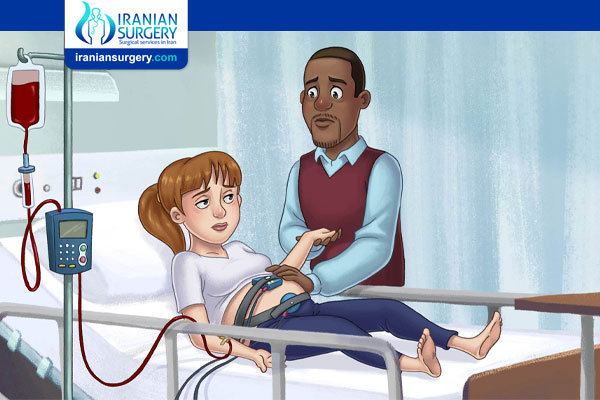HELLP Syndrome
HELLP Syndrome
What is HELLP Syndrome?
HELLP syndrome is a pregnancy complication. It is a type of preeclampsia. It usually occurs during the third trimester of pregnancy. But it also can develop in the first week after childbirth (postpartum preeclampsia).
The name HELLP syndrome stands for:
. H: Hemolysis, breaking down of red blood cells (cells that carry oxygen from your lungs to the rest of your body).
. EL: Elevated liver enzymes (chemicals that speed up body reactions, such as breaking down proteins).
. LP: Low platelet count (parts of your blood that help with clotting).
Before HELLP Syndrome Treatment
What is the difference between HELLP syndrome and preeclampsia?
Preeclampsia leads to high blood pressure (hypertension) and proteinuria (high levels of protein in the urine). HELLP syndrome is a separate disorder from preeclampsia as patients may not have high blood pressure or proteinuria. It can lead to serious blood and liver problems.
How common is HELLP syndrome?
HELLP syndrome is very rare that occurs in 0.1% to 1% of pregnancies.
What causes HELLP syndrome?
There is no known cause of HELLP syndrome. Women who have preeclampsia or eclampsia (uncontrolled preeclampsia) have a higher risk of HELLP syndrome. Up to 1 in 5 women who have preeclampsia or eclampsia develop HELLP syndrome.
Other risk factors for HELLP syndrome include:
. Age, with risk increasing for women over 25.
. History of HELLP syndrome in a previous pregnancy.
. Previous labor and delivery, with risk increasing for women who have given birth more than once before.
. Race, with white women at higher risk.
What are the symptoms of HELLP syndrome?
Women may notice HELLP syndrome symptoms while they are pregnant or shortly after childbirth. Signs of HELLP syndrome include:
. The most common symptom is abdominal pain, usually in the right upper quadrant or mid-epigastric area.
. Blurred vision.
. Malaise or fatigue.
. Edema (swelling) and quick weight gain.
. Nausea and vomiting.
. Less commonly, blurred vision or headache.
In rare cases, you may also experience:
. Uncontrolled nosebleeds.
. Seizures or uncontrollable body shakes.
Diagnosis and Tests
How is HELLP syndrome diagnosed?
To diagnose HELLP syndrome, your healthcare provider will ask you about physical changes such as:
. Belly pain, especially in the upper right side.
. Leg swelling.
Often, blood pressure can be elevated and there can be proteinuria but there doesn’t have to be. Your healthcare provider will order blood tests are ordered to check your blood count, liver function and kidney function.
In severe cases, your healthcare provider may use an ultrasound or CT scan to check for an enlarged liver or bleeding in your liver.
Prevention
How can I reduce my risk of HELLP syndrome?
There is no known way to prevent HELLP syndrome. Be sure to get regular prenatal care. Your provider will keep an eye on your blood pressure and other vital signs to catch problems like HELLP early. Your healthcare provider may recommend that you take a low dose aspirin after the first trimester if you are at high-risk for HELLP syndrome.
You can increase your chances of having a healthy pregnancy by:
. Eating a nutrient-dense diet of whole grains, lean protein, fruits and vegetables.
. Exercising moderately or as instructed by your healthcare provider.
. Scheduling regular prenatal care visits.
. Sleeping at least eight hours per night.
. Speaking with your healthcare provider about potential health risks.
During HELLP Syndrome Treatment
Management and Treatment
How is HELLP syndrome treated?
Managing HELLP syndrome may include taking medications to lower your blood pressure and prevent seizures. Some women require a blood transfusion. In this treatment, you receive donated blood or blood components.
Ultimately, treatment for HELLP syndrome is delivery. If you have HELLP syndrome, you may need to deliver your baby early. Your provider may give your baby corticosteroids to help their lungs develop.
Your healthcare provider may give you medicine to induce labor. Or you may need to deliver with a cesarean birth (C-section).
After HELLP Syndrome Treatment
Outlook / Prognosis
What is the outlook for people with HELLP syndrome?
Untreated HELLP syndrome can lead to serious complications, including:
. Blood clots.
. Heavy bleeding (hemorrhage).
. Kidney failure.
. Placental abruption (placenta separating from the uterus before birth).
. Pulmonary edema (fluid buildup in the lungs).
HELLP syndrome is rarely life-threatening. Most women experience symptom improvement within two days of giving birth.
What is the outlook for the newborn of a mother with HELLP syndrome?
In general, the longer the pregnancy continues, the better the outcome for the newborn. If a newborn weighs at least two pounds, the health risks and survival rates are similar to those of a non-HELLP baby of the same size.
Prematurity may lead to other health complications or increased mortality risk. However, HELLP syndrome itself does not affect the newborn’s liver function or other organs.
Can you get HELLP syndrome again?
If you have HELLP syndrome once, your risk increases for having it again. Up to half of women who had HELLP syndrome can have some type of hypertensive disorder in her next pregnancy. Up to 1 in 5 women who have HELLP syndrome experience it a second time.
When should I go to the ER?
HELLP syndrome can lead to severe health complications if left untreated. If you have any symptoms, please contact your provider.
Source:
. https://my.clevelandclinic.org/health/diseases/21637-hellp-syndrome


